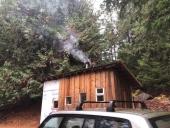
 17
17





 7
7




For all your Montana Masonry Heater parts (also known as) Rocket Mass heater parts.
Visit me at
dragontechrmh.com Once you go brick you will never go back!
 7
7




 8
8




 7
7




Leslie Walper wrote:After using this heater for a bit, I can honestly say this is the best heater I've ever burned. The fires are very consistent regardless of the type of wood being burned—hardwood, softwood, cedar, oak, ash, pine, maple, osage orange—even boxelder that has been sitting in an unsplit and uncovered pile for 3 years and has begun to get a little bit punky. Once the heater warms up it seems to be able to burn just about anything.
Leslie Walper wrote:With a better thermocouple placement there's about a 250F degree temperature increase from the firebox to the riser so I suppose there is significant combustion going on there with riser temps of about 1750F and firebox about 1500F. With that there's no outside smoke visible even when a new batch of wood is added.
Leslie Walper wrote:The only thing that continues to bother me is initial lighting and retrograde smoke out the front of the heater. I've added a TEE in the flue and light a small (2-3 sheets of newspaper) in the flue which really improves the draft. Starting with a small fire in the firebox low and directly in front of the port also helps establish the draft through the contraflow barrel, So, light the flue fire, cap the tee, then light the firebox and monitor for the need for more wood when that initial small fire stops smoking. Once the whole heater comes up to temperature adding wood to a full bed of coals is no problem. With temperatures in the low to mid 30s I've been heating about 1,400 cu/m.
regards, Peter
 5
5




 1
1




thomas rubino wrote:Pushing an 8" batch into a 6" chimney is certainly not recommended, but if it is working to your satisfaction then awesome.
Stand your 5-minute riser over the square hole and use fireclay/cob mortar to seal and support the riser.
That's it, nothing but an earthquake will cause that riser to move once the barrel is protecting it.
Using firebricks and wrapping them with insulation works fine.
It will be slower to get up to operating temperatures but will hold that heat for a long time.
Become extra-civilized!
 3
3




 6
6




 3
3




Glenn Herbert wrote:I would have made a bypass from near the top of the barrel to the exit stovepipe, so there would be a simple path for heat when starting the fire. That might have eliminated the need for the tee and paper to warm the chimney, or at least just have the paper in the back of the firebox along with kindling.

|
Let nothing stop you! Not even this tiny ad:
Homestead Pigs Course
https://permies.com/wiki/365748/Homestead-Pigs
|







